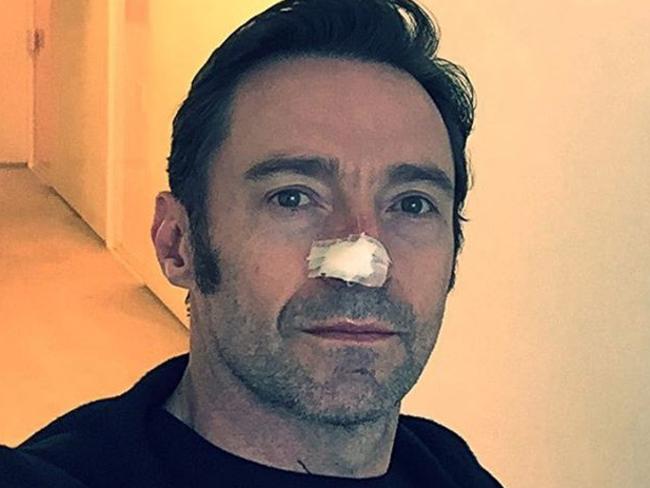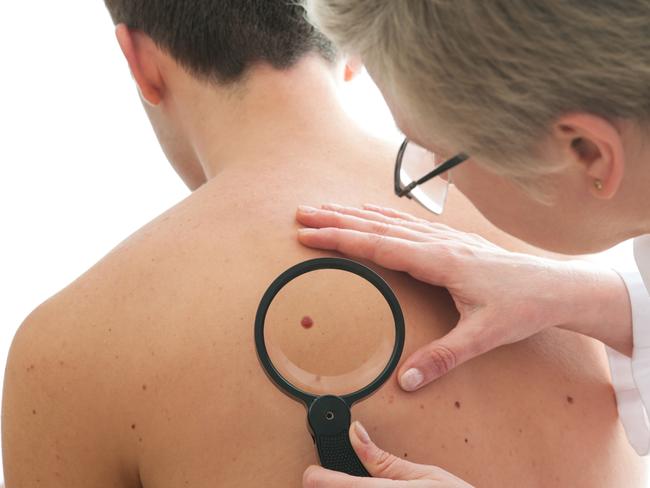Skin cancer: Why more men need to slip, slop and slap
TWO-THIRDS of Australians will be diagnosed with skin cancer by the time they turn 70, but research shows that men aren’t too concerned. They should be.

Body+Soul Daily
Don't miss out on the headlines from Body+Soul Daily. Followed categories will be added to My News.
WHAT do Hamish Blake and Hugh Jackman have in common with more than 600,000 Aussie men? If you said a love of Vegemite or a deep-seated fear of magpies, you’d probably be right, but the answer we’re looking for is skin cancer.
Back in February, Jackman took to Instagram to announce he’d had another basal cell carcinoma - a form of nonmelanoma skin cancer - removed from his face, his sixth excision to date.
Meanwhile, funnyman Blake revealed his own skin cancer scare last month, posting a photo of his bandaged nose on social media.

Respectively captioned “#wearsunscreen” and “get skin checks”, both posts were warnings about what can happen when people fail to protect themselves against the harsh Australian sun.
Tellingly, both posts were also flooded with comments from fans describing their own skin cancer experiences.
For thousands of people, the images served as a much-needed reminder to slip, slop and slap, but given that there’s almost double the incidence of non-melanoma skin cancers in men than women, and men are more than twice as likely to die from skin cancer, it seems they’re in need of an even bigger push.
MEN IN THE SPOTLIGHT
“The more sun exposure you get, the more likely you are to have skin cancer, so we’ve known that men develop skin cancer more than women for a long time,” associate professor Stephen Shumack, deputy medical director for the Skin & Cancer Foundation, explains.
“Men take part in sporting activities such as surfing, football or cricket, particularly when they’re teenagers, so they generally spend more time outdoors than women,” he says.

“Outdoor work is also more common among men, and sunscreen and sun-protective clothing like hats and long-sleeve shirts haven’t always been compulsory.”
Despite the fact that men spend a significant amount of time in the sun, a Cancer Council report revealed that only 29 per cent of men typically wore sunscreen on a summer weekend, compared to 45 per cent of women.
It’s this aversion to sun protection that may explain why men over 55 are Australia’s leading demographic for the most common type of skin cancers: basal cell and squamous cell carcinomas.
These cancers account for thousands of hospital admissions and hundreds of deaths each year. And considering the deadly melanoma variety is also more common in men, it begs the question, why are Aussie blokes so reluctant to cover up?
“[In Australia], there’s this old, macho attitude that wearing sunscreen is for wimps,” Shumack says.

Despite the rise of male grooming, men typically spend a fraction of time and money on their skin routine compared to women, so the likelihood of adding an extra cream to the mix is slim. But considering that cream is what blocks UV radiation - the main culprit in the formation of cancer cells - this attitude needs to change.
ARE YOU PAYING ATTENTION?
Whether it’s a conversation sparked by a celebrity Instagram post or a casual chat among mates, talking about (rather than ignoring) skin cancer is crucial when it comes to decreasing a man’s risk.
“A lot of men know they need sun protection but don’t always use it, so family members and partners who can emphasise the need for protection and skin checks can be very useful,” Shumack says.
“Men visit their doctors at a much later stage than women and they’re also less likely to get checked, so we need to bring as much attention to the issue of male skin cancer as possible.”
Of course, while reminders from friends and loved ones can certainly help men create sun-safe habits, in the end, it’s the guys who have to make the first move, so if you have any concerns about a skin lesion, Shumack emphasises that it’s best to see your doctor - especially if you fall into a high-risk group.

“If you have pale skin, have had high amounts of sun exposure or have a family history of skin cancer, get your skin checked,” he says.
“GPs are used to diagnosing skin lesions, and they can also give you an idea about your risk type and how often you should be checked.”
Noticed a spot that wasn’t there before?
Shumack suggests you take a photo of it.
THE 101-YEAR-OLD WHO BEAT SKIN CANCER
“Make sure you have a reference in the photograph - such as a ruler or five-cent coin - so you know how big it is, and keep track of it for a month or two,” he says.
That way you can monitor whether any changes are occurring, and you’ll also be able to show your doctor what the spot originally looked like.
If you do receive a skin cancer diagnosis, it’s important to know that although skin cancer can be frightening, thanks to recent advancements, there’s an ever-expanding list of treatment options to choose from and it may in fact be quickly and effectively treated.
“With ordinary skin cancer, such as basal cell carcinomas and squamous cell carcinomas, these lesions aren’t usually nasty and are mostly treated by cutting them out or applying a cream,” Shumack says.
“While there was very little we could do for melanoma 10 years ago, there’s quite a lot we can do now, and some treatments - such as agents that increase the immunity of the skin or inhibit the pathways that cancer uses to spread - are giving very promising results.”
As with all cancers, though, prevention is always something we can improve on.
So, guys, are you up for the challenge?
DECREASE YOUR RISK
COVER UP: If you work outside or play sports, ensure you wear a hat, sunglasses and sun-protective clothing like a long-sleeved shirt.
USE SPF: Apply 5ml (about 1 tsp) of sunscreen to your face, each arm and leg, back and torso (for a total of 35ml or about 7 tsp) 20 minutes before sun exposure and every two hours after that. The Cancer Council recommends using ones over SPF 30. Prone to sweaty skin?
Opt for a water-resistant sunscreen.
STICK TO THE SHADE: UV rays are at their weakest in the early morning and late afternoon, so try to hold barbecues in the evenings and exercise before or after work.
THE ABCs OF SKIN CANCER
One in 14 men will develop melanoma by the age of 85.
If you notice a spot that fits any of these descriptions, the Cancer Council recommends heading to your GP for a skin check.
ASYMMETRY: An irregular shape.
BORDER: An uneven border.
COLOUR: A mix of black, brown, red or white within a lesion.
DIAMETER: Any spot that’s more than 6mm in diameter.
ELEVATION: Some melanomas are lumpy rather than flat.
FIRMNESS: A bump that’s firm to the touch.
GROWTH: Any new or old lesion that begins to grow rapidly
* Today, November 19, is the start of National Skin Cancer Action Week. For info and support, visit cancer.org.au or follow the #SunSmartGeneration tag on social media.
